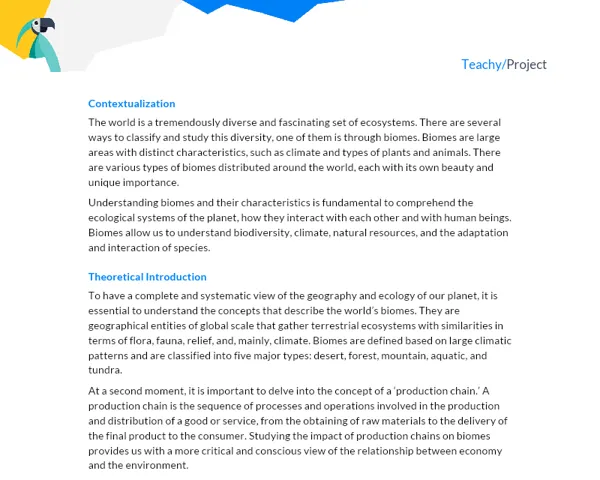Contextualization
Industries play a crucial role in the economy of a country and the world as a whole. They are responsible for most of the production in many regions and have the power to reshape landscapes, generate jobs and drive development. However, not all industries are the same. They can be classified in several ways. This section will introduce the main classifications of industries and discuss why this classification is important.
The classification of industries can be based on several criteria, such as the type of product they produce, the size of the industry, the use of technology, the level of pollution they generate, and more. Each of these classifications has its own distinct characteristics and implications. An understanding of these differences is crucial to understanding how industries operate and what their social, economic and environmental implications may be.
A classification of industries based on the type of product they produce includes, among others, basic industries, which are those that produce raw materials for others, and consumer goods industries, which produce goods for direct sale to consumers. Another important classification is the high-tech industry, which uses high technology and develops new products and processes.
Importance and Practical Applications
The classification of industries is not just a theoretical issue. It has profound implications in real life and influences many aspects of our world. For example, different types of industries have different levels of impact on the environment. Basic industries, for example, often have a significant environmental impact, while high-tech industries may have a smaller impact.
On the other hand, the products of different types of industries have distinct significance to the economy. The products of basic industries are fundamental to other industries, while the products of consumer goods industries are vital to the daily lives of consumers. Understanding this difference can also help us better understand global supply chains and how crises in one industry can affect others.
In addition, the classification of industries is deeply related to socio-economic development issues. Different types of industry have different infrastructure, capital and labour requirements, and can therefore have different impacts on the communities where they are located.
To delve deeper into the subject, I suggest reading the book "Introduction to Economics" by N. Gregory Mankiw and visiting the IBGE website, which provides data and analysis on industries in Brazil. In addition, the "Geography in Enem" channel on Youtube contains several videos that approach the topic of industry classification in a didactic and interactive way.
Practical Activity
Activity Title: "Industry and its history: an interdisciplinary study"
Project Objective:
This project's main objective is to deepen students' understanding of the classification of industries, their socio-environmental and economic impacts, as well as their historical and geographical implications.
Detailed Project Description:
The groups will develop an interdisciplinary study about the industry of their choice. Initially, the students should focus on classifying the industry according to the different parameters discussed - type of product, use of technology, etc.
Next, they should explore the socio-environmental impacts of this industry, comparing different points of view and evaluating its economic implications. The relationship between this industry and geography should also be studied, including how it influences and is influenced by local, regional and global geography.
Finally, students should make a critical reflection on the ethical implications of the industry, considering issues of social justice, human rights and environmental impact.
Required Materials:
- Internet access for research;
- Geography, History and Economics books;
- Pens, papers and/or computers to write the report.
Detailed Step-by-Step Instructions for the Activity:
-
Form groups of 3 to 5 students.
-
Each group should choose an industry to study, which will be analysed throughout the project. The choice should be conscious and strategic, based on the classifications discussed in class.
-
Students should research and collect information about the chosen industry, classify it according to different parameters and well document their reasons and research sources.
-
Next, students should investigate the socio-environmental impacts of the chosen industry, evaluating the importance of the industry to the economy, workers and society as a whole.
-
Students should map the presence and influence of this industry in local, regional, and global geography.
-
Ultimately, students should reflect on the ethical issues related to the chosen industry, focusing on issues of social justice, human rights, and environmental impact.
-
Each group should prepare a detailed report of the study, including Introduction, Development, Conclusions and Bibliography. The report should follow the guidelines given at the beginning of this document.
Project Deliverables and Articulation with Activities:
The final project deliverable is a written report, which should reflect the activities carried out throughout the project.
The report should begin with an introduction, where students contextualize the theme, discuss its relevance and explain why they chose the industry in question. Then, they should present the data collected about the industry and its classification, explaining in detail the methodology used for the classification.
In the development section, students should discuss in depth the socio-environmental and economic impacts of the industry, as well as its relationship with geography. They should present and discuss the results obtained, based on solid evidence and well-founded arguments.
In the conclusion, students should analyse the ethical implications of the studied industry, pointing out possible solutions for the identified problems. They should review the main points discussed and the lessons learned during the project.
Finally, in the bibliography, students should list the sources used in the research, including books, websites, videos, among others.


